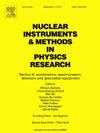将 FastIC 前端电子设备集成到 Picosec MicroMegas 探测器中
IF 1.5
3区 物理与天体物理
Q3 INSTRUMENTS & INSTRUMENTATION
Nuclear Instruments & Methods in Physics Research Section A-accelerators Spectrometers Detectors and Associated Equipment
Pub Date : 2025-04-12
DOI:10.1016/j.nima.2025.170496
引用次数: 0
摘要
Picosec MicroMegas合作旨在开发气体快速定时探测器;在实验中,根据探测器的具体配置,可以获得大约50ps到20ps以上的固有时间分辨率。部分开发重点是探索各种快速时序多通道前端电子器件的选择,以满足实验应用的数据处理需求。一种选择是FastIC,它被开发用于读取具有固有放大的正、负输入极性传感器。本文介绍了用FastIC读出气体皮秒微兆气体探测器的初步结果。在实验室研究中,使用函数生成器对数据处理链进行基本描述。测试光束测量的结果用于表征FastIC和Picosec MicroMegas组合的定时性能和电荷处理,以及演示多通道探测器读出的可能性。尽管FastIC的阈值计时水平引入了大约1.5ns的时间行走,但已经实现了大约50ps的时间分辨率。本文章由计算机程序翻译,如有差异,请以英文原文为准。
Integration of the FastIC front-end electronics into the Picosec MicroMegas detector
The Picosec MicroMegas collaboration aims to develop gaseous fast-timing detectors; experimentally, intrinsic time resolutions from around to better than are obtained, depending on the exact detector configuration. Parts of developments focus on exploring various options of fast-timing multi-channel front-end electronics, to meet the data processing demands of experimental applications. One option is the FastIC, which was developed for reading out positive and negative input polarity sensors with intrinsic amplification. In this paper, the first results from reading out the gaseous Picosec MicroMegas detector with the FastIC are presented. In laboratory studies, a basic description of the data processing chain was performed using a function generator. The results from test beam measurements are used to characterise the timing performance and the charge processing of the combination of FastIC and Picosec MicroMegas, as well as to demonstrate the possibility of a multi-channel detector readout. Although the timing-at-threshold level of the FastIC introduces a time walk of around , time resolutions of around have been achieved.
求助全文
通过发布文献求助,成功后即可免费获取论文全文。
去求助
来源期刊
CiteScore
3.20
自引率
21.40%
发文量
787
审稿时长
1 months
期刊介绍:
Section A of Nuclear Instruments and Methods in Physics Research publishes papers on design, manufacturing and performance of scientific instruments with an emphasis on large scale facilities. This includes the development of particle accelerators, ion sources, beam transport systems and target arrangements as well as the use of secondary phenomena such as synchrotron radiation and free electron lasers. It also includes all types of instrumentation for the detection and spectrometry of radiations from high energy processes and nuclear decays, as well as instrumentation for experiments at nuclear reactors. Specialized electronics for nuclear and other types of spectrometry as well as computerization of measurements and control systems in this area also find their place in the A section.
Theoretical as well as experimental papers are accepted.

 求助内容:
求助内容: 应助结果提醒方式:
应助结果提醒方式:


